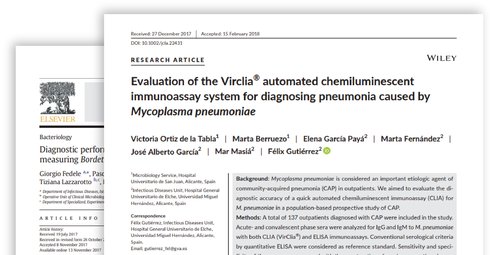It is a pleasure to inform you that the list of VirClia® publications continue to grow. Please find below the latest 2 publications available:
- Diagnostic performance of commercial serological assays measuring Bordetella pertussis IgG antibodies
Fedele et al. (2018) compare the diagnostic performance of commercially available enzyme-linked immunosorbent assays (ELISAs) and chemiluminescent immunoassays (CLIAs), measuring IgG against Bordetella pertussis antigens.
They demonstrate how commercial assays based on purified pertussis toxin (PT) and quantifying the results expressed in IU/mL, have a better performance and excellent diagnostic accuracy as compared to those using a mixture of different antigens.
The results also highlight the highest diagnostic performance achieved by an indirect CLIA in comparison with ELISA tests and the importance of having a fast and fully automated procedure.
Bordetella pertussis Toxin VirClia® IgG Monotest is a CLIA-based and fully automated system, presented here as a simple, fast and reliable tool to quantitatively test IgG antibodies against Bordetella pertussis.
- Evaluation of the Virclia® automated chemiluminescent immunoassay system for diagnosing pneumonia caused by Mycoplasma pneumoniae
Ortiz de la Tabla et al. (2018) evaluate the diagnostic accuracy of the VirClia® system for Mycoplasma pneumoniae in a population-based prospective study of community-acquired pneumonia (CAP).
After performing IgG and IgM analysis of acute and convalescent phase sera with both VirClia® and ELISA immunoassays, the authors conclude that Mycoplasma pneumoniae VirClia® Monotest is a more efficient technique in comparison with ELISA, since it provides a much higher average value of the coefficient between the convalescent and acute samples, due to its greater dynamic range.
We invite you to visit the bibliography section of our website to see the full list of publications.


